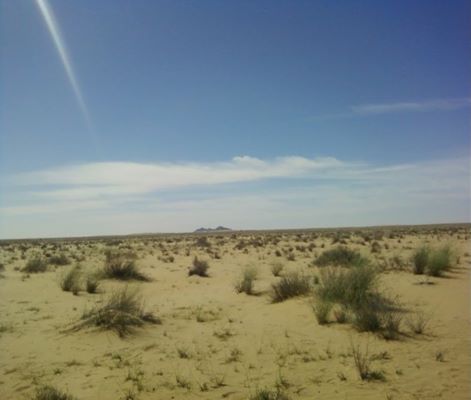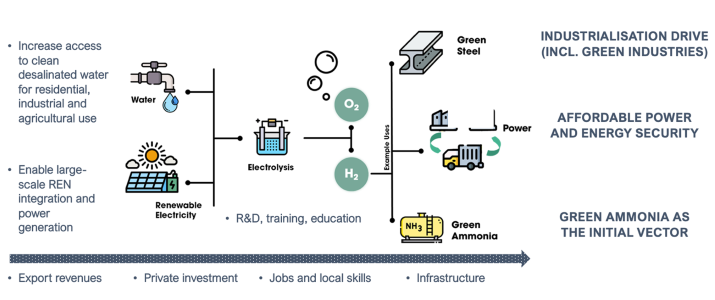Green hydrogen
Chariot & Total Eren - Project Nour in Mauritiania
|
Basic description Total Eren is a French-based renewable Independent Power Producer (IPP) active in the development, financing, construction and operation of solar and wind farms globally. Total Eren relies on unique shareholder group which includes TotalEnergies, a large global energy company. Chariot is an energy group focused on providing cleaner energy across the African continent, in particular via its Green Hydrogen business stream. Chariot and Total Eren aim to secure and develop scalable, first-mover positions in energy transition projects, including green hydrogen. While working together on renewable power projects for mines across Africa, the two companies have also partnered to co-develop “Project Nour”, a green hydrogen project located in Mauritania. The project spans land areas across northwestern Mauritania and covers a total area of 5 000 km² benefitting from one of the world’s best combined solar and wind resources. The pre-feasibility study carried out in 2021-22 confirmed the project’s potential of up to 1.2 million tonnes (Mt) of green hydrogen production per year by 2030. Nour will be built in phases with a total electrolyser capacity of up to 10 gigawatts (GW). A Framework Agreement with the Government of Mauritania is now in place which defines the terms and guiding principles for the in-depth feasibility study that will be undertaken over a period of 24 months. Project rationale Green hydrogen is an essential component for decarbonising energy-intensive regions. The combined solar and wind resources in Mauritania allow the project to make use of low-cost renewable energy for green hydrogen production. The proximity to Europe allows for cost-effective transport of green hydrogen or green ammonia to the continent. In addition, Project Nour has the potential to contribute significantly to Mauritania’s gross domestic product, and its society at large. Chariot and Total Eren are working in partnership with the Government of Mauritania to support its ambition to become a leading producer and exporter of green hydrogen. The project has the potential to create a range of positive socio-economic impacts in Mauritania through increased investments, job creation, and increased government revenues. Nour could help create thousands of jobs during both the construction and operational phases. The integration of large-scale renewable generation could provide baseload power to the national grid and improve Mauritania’s energy security. In addition, Nour could contribute to developing local infrastructure. |
 |
 |
Business model Some of the major future demand regions for clean energy, including Europe, may require importing low-cost hydrogen and derivatives from abroad to meet their decarbonisation targets and remain competitive. Thus, one option for Project Nour will be to export hydrogen in the form of green ammonia. This could be facilitated by the high level of maturity of transport and trading of ammonia. Green ammonia can be used directly, for instance, as a maritime fuel, as a chemical feedstock, or to generate electricity. Furthermore, green ammonia could be used as a clean energy carrier. In addition, unlocking local offtake of green hydrogen and capitalizing on synergies with Mauritania’s existing local iron ore sector could create in-country value for the extractive sector. Localizing parts of the green steel value chain – by building a local green steel industry to upgrade the ore in Mauritania – would increase supply chain resilience and create many opportunities for local content. Nour benefits from geographical proximity to Nouadhibou (Mauritania’s deep-sea port) and to large European markets, with the potential to make Mauritania one of the world’s main producers and exporters of green ammonia. |
The European Union (EU) is supportive of Mauritania’s green growth plans and is looking to strengthen its cooperation in renewable energy and green hydrogen. Nour could provide a cost-effective solution to replace CO2 emitting fuels in the main European markets and beyond. In April 2022, Chariot signed an agreement with the Port of Rotterdam, which was a first step in establishing supply chains to enable the sale of green hydrogen and its derivative products (notably ammonia) into Europe.
Governance
Chariot and Total Eren are jointly developing the project as equal shareholders. They will benefit from the expertise of Total Eren’s and TotalEnergies’ various teams, holding a wide range of experience and knowledge in solar, wind, hybrid, and green hydrogen projects globally.
The consortium plans to engage with leading suppliers early in the first phase to start securing manufacturing capacities, select the optimal technologies and build reliable foundations prior to scaling up the project to its full potential.
Enabling market conditions and de-risking investment
Optimised phasing provides the stepping-stone towards achieving large-scale green hydrogen and ammonia production. Project phasing will contribute to reducing debt requirements and improving risk appreciation over time. Project Nour is specifically designed to ramp up in multiple phases as global demand for green hydrogen and ammonia increases, to allow revenue generation early in the project and optimise the cost of the capital, which remains a key challenge.
Securing offtake for green hydrogen projects is important for mobilising investment. Local consumption will be a key enabler and an early focus of Project Nour. Capturing early local use opportunities mitigates the need for export infrastructure while allowing for in-country value creation. This, and further phasing, can also improve the financial attractiveness of Nour by leveraging decreasing costs of technology (electrolysis in particular) with early revenue generation and learning-by-doing.
The partners have a long-standing working relationship and extensive experience in renewables. The project will also benefit from TotalEnergies’ in-house expertise to deliver projects of this magnitude. In addition, the partners will be able to leverage TotalEnergies’ expertise in LNG production, trading and shipping, regasification and supply, and market development to deploy a strong green hydrogen and green ammonia supply chain globally.
Financing
Given the capital intensity of the project, Chariot and Total Eren are currently defining the optimal capital structure. The project will be designed to ramp up in increasing phases of capital expenditure to allow for early revenue generation, electrolyser cost reduction and efficiency improvement. Indeed, as some equipment costs may decrease strongly, driven by economies of scale and technology learning, the earlier phases are required to drive learning and cost reduction, and the latter phases would benefit from more competitive pricing.
The consortium has strong equity and extensive project finance expertise with decades of experience in project finance for the energy sector. In addition, it has access to a competitive network of commercial banks and DFIs that have already shown strong interest in financing Nour.
Exploring local consumption opportunities under the first phase that delays the need for initial expenditure on export infrastructure and securing export offtake agreements for later phases would facilitate financing the project.
On the funding side, strategic financing institutions are expected to play an important role in Project Nour, particularly for the first phases. The exporting nature of green hydrogen projects alongside the novelty of such a significant project means that export credit agencies and Development Finance Institutions (DFIs) will play an important role in the financing structure. For instance, the European Investment Bank (EIB) and Mauritania have signed a declaration in June 2022 to co-operate and support the country’s green hydrogen investment plans. As an early-mover within the green hydrogen space, the consortium may be able to leverage its position by gaining access to advantageous financing and subsidy schemes to facilitate their development and scaling-up.
Related Documents